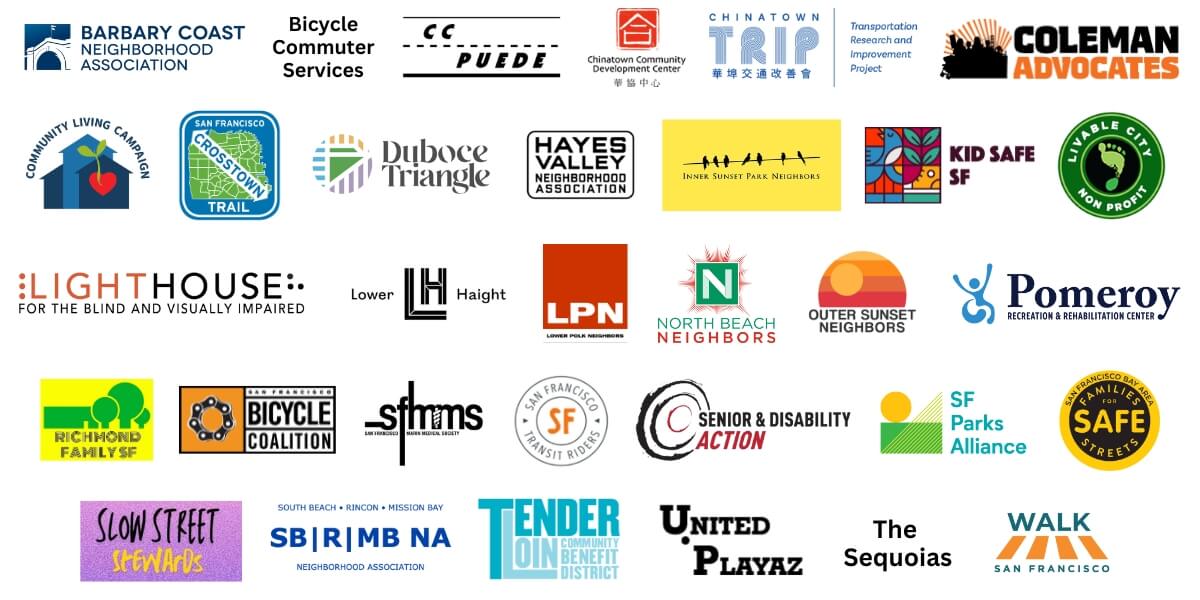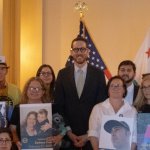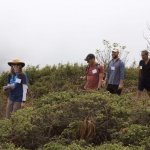Vision Zero Coalition releases shared priorities for safe streets to all City leaders
Special thanks to Rahman Law for their generous support of the Vision Zero Coalition’s efforts.
Earlier today, we went to City Hall on behalf of the 30+ community-based organizations, nonprofits, and civic groups that are part of the Vision Zero Coalition. We delivered the letter below directly to Mayor London Breed and all members of the Board of Supervisors.
The shared recommendations in this letter are meant to focus and strengthen the City’s efforts on Vision Zero, and show how broad and diverse support for safe streets and strong neighborhoods throughout San Francisco.

Mayor London Breed and Board of Supervisors
City Hall
1 Dr. Carlton B. Goodlett Place
San Francisco, CA 94102
Dear Mayor Breed and Board of Supervisors,
As community-based organizations, nonprofits, and civic groups from across the city, the Vision Zero Coalition seeks to support the City in making streets truly safe.
For the past several months, we have worked together toward this moment: sharing with you and all City leaders what we believe is needed to accelerate Vision Zero progress.
We are grateful for your leadership and commitment to Vision Zero. We know that you understand that strong neighborhoods and safe streets go hand-in-hand.
Our shared recommendations are meant to help focus and strengthen the City’s efforts and also show how broad and diverse support for Vision Zero is throughout San Francisco. Traffic safety is an urgent issue that affects us – and everyone we work with and represent – each and every day.
Sincerely,
Barbary Coast Neighborhood Association
Bicycle Commuter Services
CC Puede
Chinatown Community Development Center
Chinatown TRIP
Coleman Advocates for Children & Youth
Community Living Campaign
Duboce Triangle Neighborhood Association
Hayes Valley Neighborhood Association
Inner Sunset Park Neighbors
Kid Safe SF
LightHouse for the Blind and Visually Impaired
Livable City
Lower Haight Merchants and Neighbors Association
Lower Polk Neighbors
North Beach Neighbors
Outer Sunset Neighbors
Pomeroy Recreation and Rehabilitation Center, Inc.
Richmond Family SF
San Francisco Bicycle Coalition
San Francisco Marin Medical Society
San Francisco Transit Riders
Senior and Disability Action
San Francisco Bay Area Families for Safe Streets
San Francisco Crosstown Trail
San Francisco Parks Alliance
Slow Streets Stewards
South Beach | Rincon | Mission Bay NA
Tenderloin Community Benefit District
The Sequoias
United Playaz
Walk SF
CC: SFCTA Director, Tilly Chang; SFMTA Director, Jeffrey Tumlin; SFDPH Director, Grant Colfax; SFDPW Director, Carla Short; SFPD Chief, William Scott; SFFD Interim Chief, Sandy Tong; SFUSD Superintendent, Matt Wayne; SFMTA Board Members; SF Police Commissioners; SF Fire Commissioners; SF Heath Commissioners; SF Public Works Commissioners; SF School Board
Safe Streets
Strong Neighborhoods
Ten years ago, San Francisco was the third city in the nation to adopt Vision Zero: a comprehensive, proven approach to end severe and fatal traffic crashes.
The City’s work since is moving San Francisco in the right direction, but not fast enough.
The number of people who continue to be hurt and killed in traffic crashes – particularly those outside a vehicle – show the solutions are not yet sufficient for the problem. Traffic violence threatens not only our lives, but our quality of life.
Together, as community-based organizations, nonprofits, and civic groups from across the city, we urge the City to focus on crucial actions to accelerate Vision Zero progress. This is informed by months of researching best practices from leading Vision Zero cities around the world, as well as our Coalition’s assessment of San Francisco’s successes and shortcomings since 2014.
We believe in Vision Zero, as an approach and as a goal. At its core, Vision Zero is a commitment to do everything possible to prevent suffering, trauma, and tragedy on our streets.
Because when streets and sidewalks are safe for everyone, especially children, seniors, and people with disabilities, a more expansive vision is also within sight. A vision where our streets are our collective commons, accessible to everyone, and the heartbeat of our city. A vision where when you walk out any door, everything you need is easily reachable in many ways. And this vision builds on itself as the city grows, with safe streets and climate-friendly transportation choices together forming the foundation of San Francisco’s best future.
Realizing Vision Zero means a more equitable, resilient San Francisco, with strong, thriving neighborhoods where we are more connected to each other and our communities.
Our shared recommendations as the City recommits to Vision Zero
Do not lose focus on the high-injury network and Equity Priority Communities.
Despite the City’s progress in redesigning some of the worst offenders on the high-injury network – the 12% of streets where 68% of crashes occur – much work remains. The 2023 report conducted by Fehr & Peers for the SFMTA recommended additional safety fixes on 74% of high-injury streets.
The City must continue to focus on the crash data when it comes to Vision Zero priorities, especially given the high concentration of high-injury streets in Equity Priority Communities. There are still five- and six-lane streets cutting through neighborhoods, with deadly speeding. These streets are loud, polluting, dangerous, and oppressive to the people who live nearby. They limit access, mobility, and opportunity, perpetuating decades of transportation inequities. These streets – and their surrounding communities – must be priorities for change.
Do bring all available solutions to scale, starting with the high-injury network.
Some of the leading Vision Zero cities in the United States are showing what happens when solutions are brought to scale.
Hoboken, New Jersey has gone seven years without a single traffic death. This success is in part because of how they have added daylighting at every single intersection. Daylighting, which prevents parking around an intersection so there are clear sightlines, is different in Hoboken. At every single intersection, Hoboken has installed posts (or parklets or bike parking) to protect daylighting from illegal parking so this simple safety tool can improve safety all day, every day, everywhere. Yes, Hoboken is smaller than San Francisco, but this city shows how small changes can make a big difference when applied at scale.
New York City, which pioneered putting posts and rubber bumpers in intersections to slow turning drivers starting in 2016, now has turn calming at nearly 900+ intersections. Turn calming reduces pedestrian injuries by 20%, so at scale is contributing to New York City’s progress in Vision Zero in a meaningful way.
Most of the safety solutions needed on our streets are readily available, affordable, and already being used in San Francisco. But San Francisco must apply them at scale, first on the high-injury network (starting with Equity Priority Communities), and then beyond, for Vision Zero to succeed. Safety solutions must also be layered, so if one fails, another can serve as backup. This is at the core of achieving a preventative system, which reduces the chances of a severe or fatal crash happening in the first place.
Do streamline how all streets are delivered to meet a consistent and high bar for safety.
San Francisco’s ‘Vision Zero Quick Build’ program has been able to cut a lot of red tape in redesigning streets for greater safety. Build on this success, so that every time any street is repainted, repaved, or redesigned it gets a full suite of by-right safety solutions. Consistency can also prevent controversy, with baseline safety requirements for different types of streets.
Many Vision Zero cities have ‘Complete Streets’ policies that have helped institutionalize safe street design, smooth coordination between agencies, and save money. Cambridge, MA, Howard County, MD, and Oakland, CA are examples to look toward.
Other cities are applying a ‘by-right’ approach in specific areas of street design. Boston now adds ‘vertical speed reducers’ (like speed humps and tables) where data show they’re needed as part of a broader speed strategy, rather than based on one-by-one requests from individual residents. This way, safety tools are installed faster, more strategically, and more equitably.
Do have all City agencies play their part in Vision Zero, held to account by the Mayor.
In recent years, much of Vision Zero implementation has fallen on the SFMTA. But other departments play crucial roles. We need true interagency commitment and collaboration, with all agencies held to account by the Mayor. Otherwise, projects can get watered down and delayed, putting people at risk.
Each relevant City agency and department – the SFMTA, the SF Department of Public Health, the SF Police Department, Public Works, Public Utilities Commission, and the Fire Department – should not just be signed on as a Vision Zero partner, but have detailed annual commitments to make streets safer, working together. Each must report progress against goals regularly (at least quarterly) to the Mayor’s Office, with the Mayor breaking down barriers and driving progress.
Do create more transparency with annual objectives and outcomes-based metrics, and a single citywide dashboard.
Vision Zero is ambitious, seeking to end fatalities and serious injuries on city streets. As with any ambitious goal, the way to get there is to break it down into annual objectives that can together get to that bigger goal. Right now, the public cannot see progress; all we know is that we’re not yet at zero. When the public can see comprehensive plans and outcomes-based metrics, there will be greater support and understanding of the City’s good work and progress.
The SFMTA’s current ‘Safe Streets Dashboard’ shows only the number of projects completed, without showing the total planned. This is like getting a math score on a test: 8. Is it out of 10? Or 100? Without knowing the objective, we can’t see progress.
Washington DC is a role model, with a range of performance indicators around vehicle speeds, driver yield rates, reductions in conflicts/near-misses at intersections, and more. San Francisco needs a public dashboard that shows progress towards safe streets objectives that will get to Vision Zero. This is a fundamental tool for good government, but also can help drive the work forward.
Do plan for what’s needed to succeed with Vision Zero.
We recognize that resource constraints have meant the City has been in a position of planning for what’s possible instead of what’s needed with Vision Zero. We also recognize that the City is having to undo decades of automobile-centered street design.
But it’s crucial that San Francisco think and act bigger in implementing Vision Zero. The best way for the City to do this is through scenario planning for the next two, five, and ten years of Vision Zero at different funding levels – including fully exploring what a robust funding scenario could deliver.
The City’s excellent ‘Vision Zero Quick Build’ program, which redesigns streets for greater safety using inexpensive tools like paint, posts, rubber bumpers, signal changes, and signage, can do a lot of what’s needed. But capital projects that install solutions like concrete islands, bulbouts, and bollards are also needed. Improving Slow Streets and creating a complete, safe and inviting bike-and-roll network will take more investment. So will future expansion of speed cameras and other speed-slowing tools – and our public transportation must be frequent, reliable, and convenient. What would it cost to do what’s really needed?
Scenario planning will give the public greater understanding of what’s possible within current funding constraints and what tradeoffs are at play. It could yield needed solutions and efficiencies, and stronger short-term Vision Zero Action Strategies.
Our coalition is ready to support scenario planning, and to work to win the funding needed so Vision Zero can succeed.
Don’t underestimate the benefits of transforming our streets.
Embracing Vision Zero with speed, scale, and accountability will transform San Francisco’s streets. That in turn will encourage people to choose to walk, bike, and take transit – making a “mode shift” away from car trips – a critical part of meeting our city’s transportation and climate goals. This will also improve public health, reducing injuries and death, increasing physical activity, and improving air quality. Just reducing crashes can save a lot of money, as an analysis recently found in New York City.
A quieter, cleaner, less trafficky city with welcoming streets will in turn build foot traffic, inviting visitors and residents alike to walk to, shop, and eat and drink at more local businesses.
Safe streets are what strong neighborhoods and a thriving city are built on.




